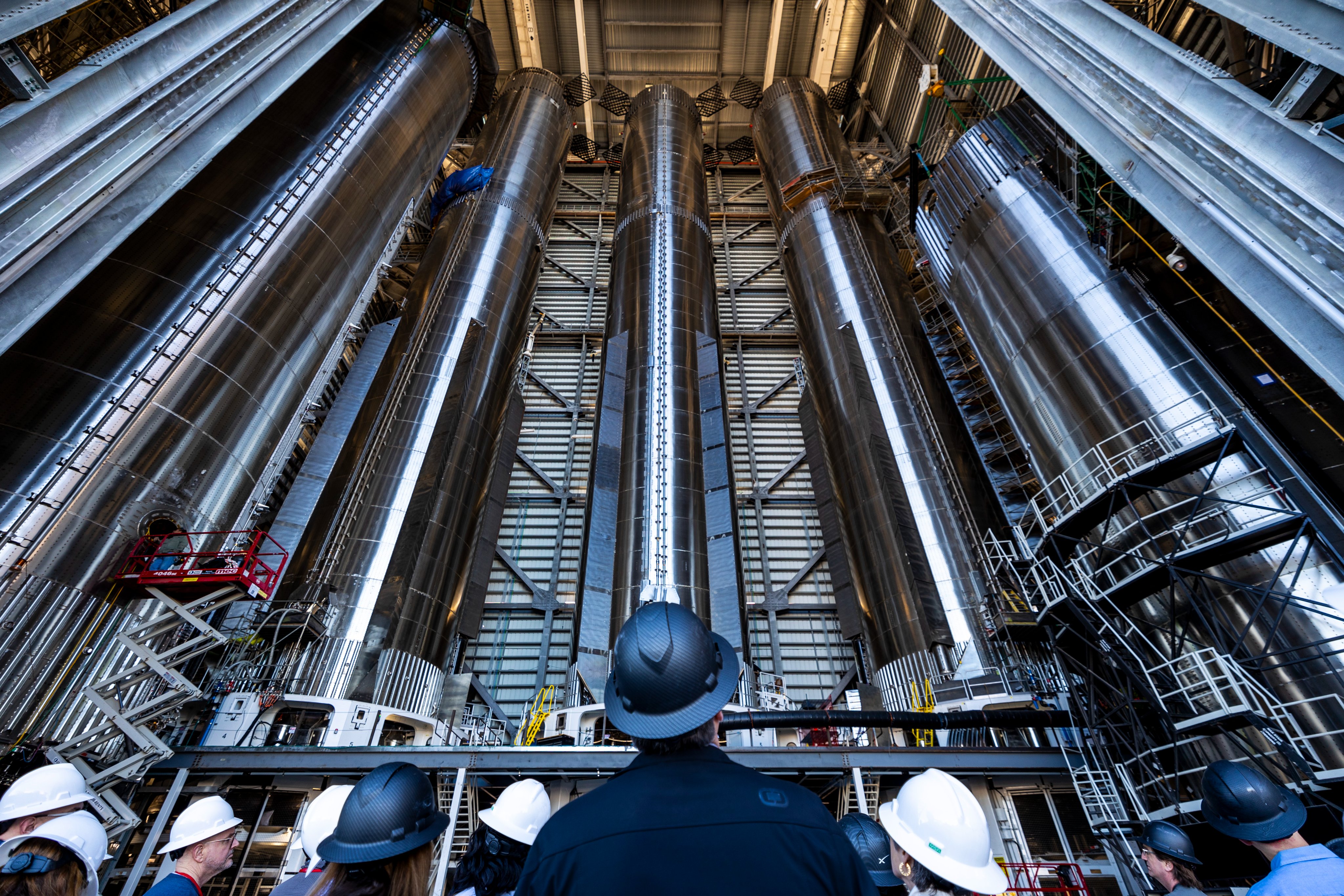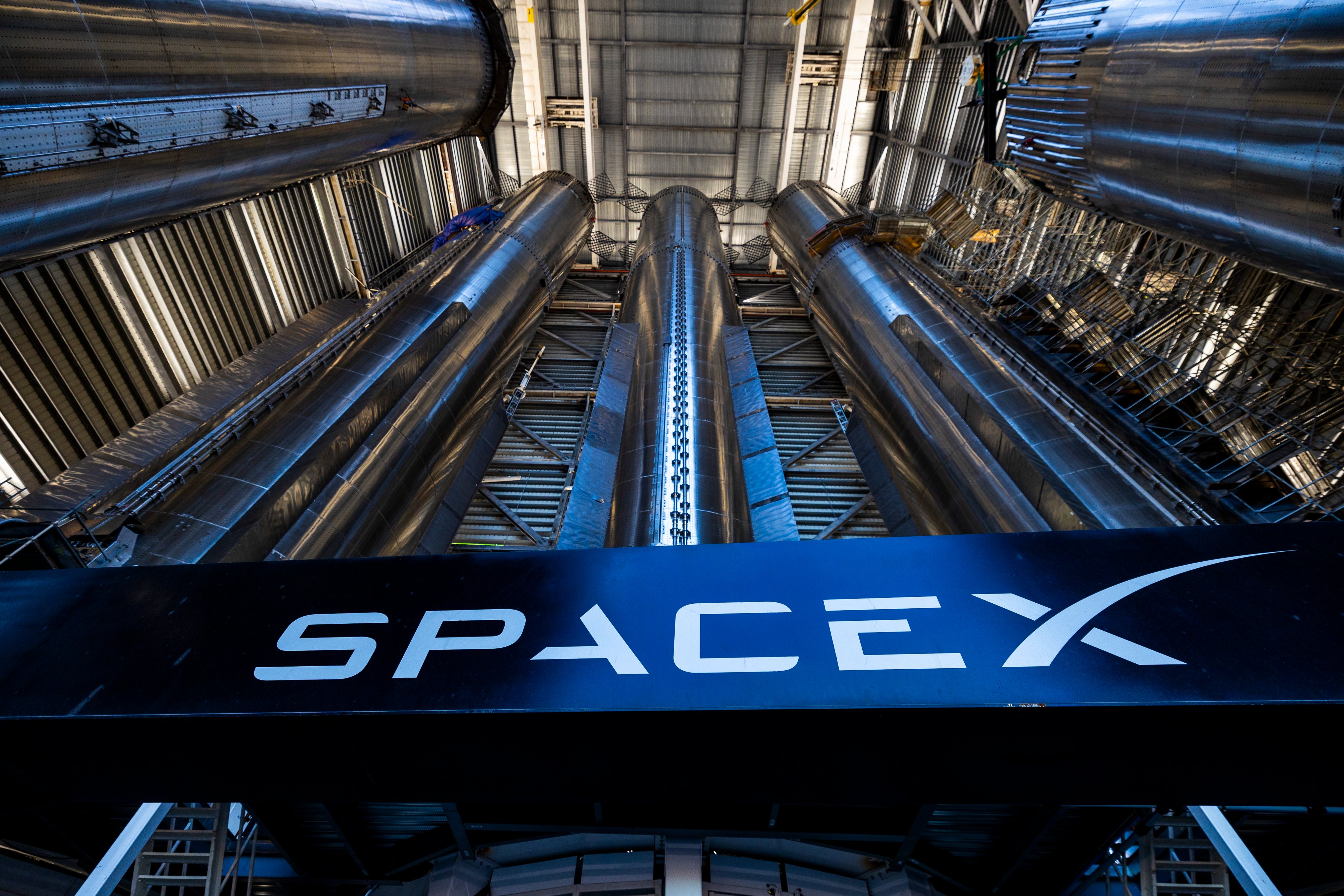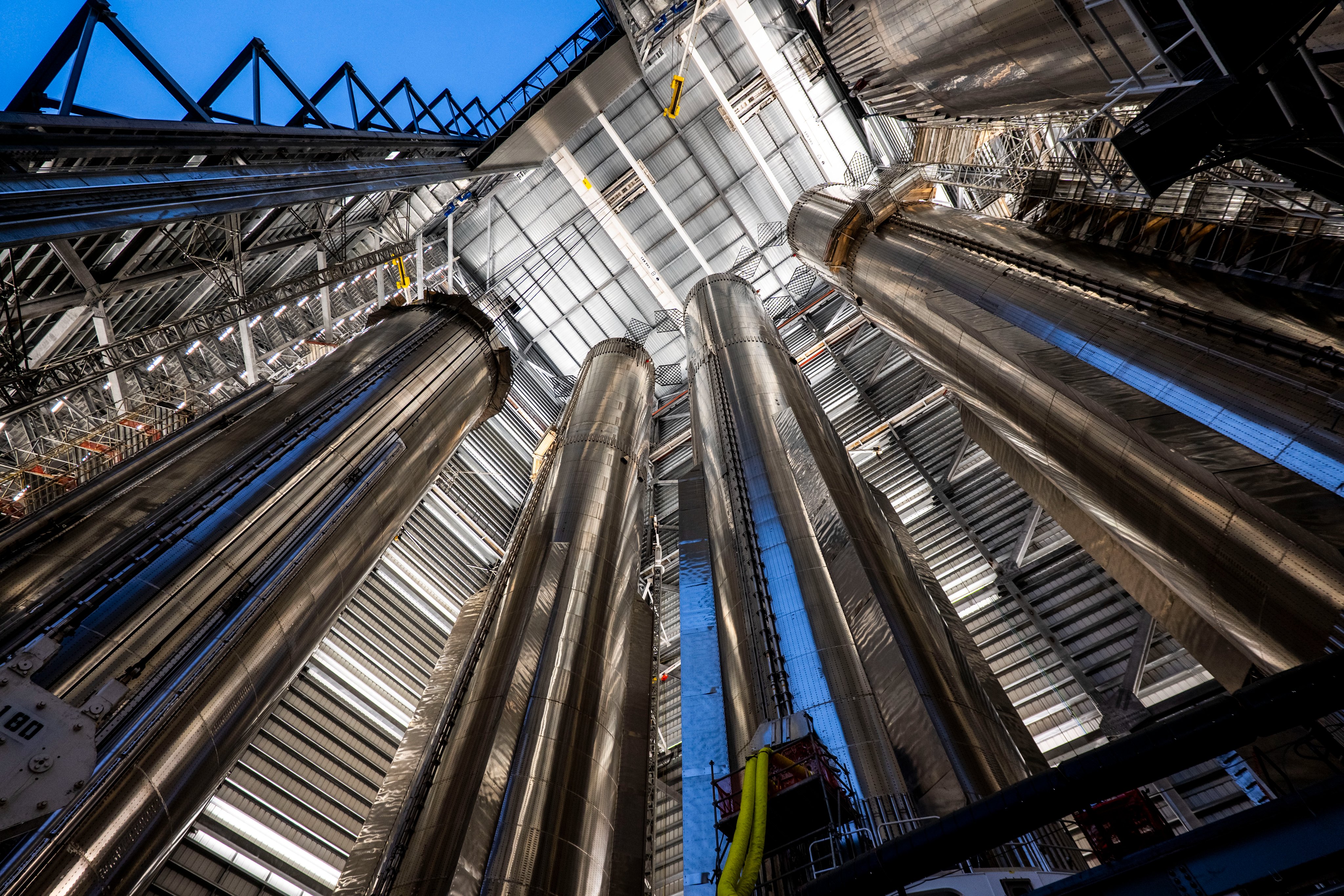SpaceX Starship Test Program
- Thread starter Crispy75
- Start date
- Tech/Gadgets OT
You are using an out of date browser. It may not display this or other websites correctly.
You should upgrade or use an alternative browser.
You should upgrade or use an alternative browser.
Difference between first and second launch.
View: https://x.com/rgvaerialphotos/status/1725949574567600283?s=61&t=ibsS0wDgi_2qddo-rUQe1g
context?
Last time it launched, the launch destroyed the concrete ground level and dug that hole, and sent debris flying. They got fined over it.
This time around everything seems intact.
Both are pictures of the launch pad after the last 2 tests flight.
On the left is a picture of the pad after the first flight. Note the crater between the legs.
On the right is a picture from today after the flight. The pad is seemingly intact.
SpaceX made a bunch of upgrades to try and avoid repeating what happened after the first launch and it seems like it worked. Mainly, they poured some humongous foundations, added a steel plate below the engines and made and tested a water deluge system that is basically an inverted shower head that shoots water up from the ground towards the engines at lift off.
Difference between first and second launch.
View: https://x.com/rgvaerialphotos/status/1725949574567600283?s=61&t=ibsS0wDgi_2qddo-rUQe1g
So it turns out rocket fuel can't melt steel plates.
Some more details from SpaceX:

They specify FTS for Starship, but it looks like Super Heavy blew up all on it's own.
The boost-back burn was obviously off-nominal, with multiple engines failing to re-light or re-lighting then failing shortly afterwards, but it seems there was a more significant failure in-progress by this point.

On November 18, 2023, Starship successfully lifted off at 7:02 a.m. CT from Starbase in Texas and achieved a number of major milestones:
All 33 Raptor engines on the Super Heavy Booster started up successfully and, for the first time, completed a full-duration burn during ascent.
Starship executed a successful hot-stage separation, powering down all but three of Super Heavy's Raptor engines and successfully igniting the six second stage Raptor engines before separating the vehicles. This was the first time this technique has been done successfully with a vehicle of this size.
Following separation, the Super Heavy booster successfully completed its flip maneuver and initiated the boostback burn before it experienced a rapid unscheduled disassembly. The vehicle breakup occurred more than three and a half minutes into the flight at an altitude of ~90 km over the Gulf of Mexico.
Starship's six second stage Raptor engines all started successfully and powered the vehicle to an altitude of ~150 km and a velocity of ~24,000 km/h, becoming the first Starship to reach outer space and nearly completing its full-duration burn.
The flight test's conclusion came when telemetry was lost near the end of second stage burn prior to engine cutoff after more than eight minutes of flight. The team verified a safe command destruct was appropriately triggered based on available vehicle performance data.
The water-cooled flame deflector and other pad upgrades performed as expected, requiring minimal post-launch work to be ready for upcoming vehicle tests and the next integrated flight test.
All 33 Raptor engines on the Super Heavy Booster started up successfully and, for the first time, completed a full-duration burn during ascent.
Starship executed a successful hot-stage separation, powering down all but three of Super Heavy's Raptor engines and successfully igniting the six second stage Raptor engines before separating the vehicles. This was the first time this technique has been done successfully with a vehicle of this size.
Following separation, the Super Heavy booster successfully completed its flip maneuver and initiated the boostback burn before it experienced a rapid unscheduled disassembly. The vehicle breakup occurred more than three and a half minutes into the flight at an altitude of ~90 km over the Gulf of Mexico.
Starship's six second stage Raptor engines all started successfully and powered the vehicle to an altitude of ~150 km and a velocity of ~24,000 km/h, becoming the first Starship to reach outer space and nearly completing its full-duration burn.
The flight test's conclusion came when telemetry was lost near the end of second stage burn prior to engine cutoff after more than eight minutes of flight. The team verified a safe command destruct was appropriately triggered based on available vehicle performance data.
The water-cooled flame deflector and other pad upgrades performed as expected, requiring minimal post-launch work to be ready for upcoming vehicle tests and the next integrated flight test.
They specify FTS for Starship, but it looks like Super Heavy blew up all on it's own.
The boost-back burn was obviously off-nominal, with multiple engines failing to re-light or re-lighting then failing shortly afterwards, but it seems there was a more significant failure in-progress by this point.
The launch was incredible. I'm curious how they're going to get meaningful payload to orbit considering both vehicles were basically out of fuel. Or perhaps I'm thinking about it the wrong way.
We have had no indication that both vehicles were out of fuel. And the second stage was less than a minute away from reaching orbit speed when it was terminated. SpaceX stated goal is to go over a 100 tons to orbit long term.The launch was incredible. I'm curious how they're going to get meaningful payload to orbit considering both vehicles were basically out of fuel. Or perhaps I'm thinking about it the wrong way.
Last edited:
Yea, the negative acceleration experienced during the hot staging seems to have caused the booster to fail because they likely had a mix of propellant slosh and propellant hammer possibly ripping apart the plumbing when the center engines on the boost back burn started up.The boost-back burn was obviously off-nominal, with multiple engines failing to re-light or re-lighting then failing shortly afterwards, but it seems there was a more significant failure in-progress by this point.
I wish they would have explained in more detail why the FTS was triggered on the Starship.
I wish they would have explained in more detail why the FTS was triggered on the Starship.
There is a lot of speculation in the community that there was a liquid Oxygen leak, leading to there being insufficient propellant to reach the desired trajectory. Once the FTS detected the craft was outside it's planned flight path it would have triggered.
the official release broadly fits what was suggested by an "unnamed source" a few days ago, which was that they did not know at the time what happened to starship (they had theories) but that super heavy had too much momentum going into the flip and fuel slosh led to gas bubbles in the engines. which is quite fixable.
current starship theory is that there was a lox leak somewhere (there's a plume of... something... visible on camera at like t+7:00 and the measurements on the stream start showing an increased loss in lox) but they have not said what caused it. if they even know.
overall the flight went well enough that my guess is next test will be "try to sit superheavy above the ocean and finely control its position to demonstrate ability to be caught, test starship orbital re-entry and see the effect on the heat shield". probably sometime in january.
current starship theory is that there was a lox leak somewhere (there's a plume of... something... visible on camera at like t+7:00 and the measurements on the stream start showing an increased loss in lox) but they have not said what caused it. if they even know.
overall the flight went well enough that my guess is next test will be "try to sit superheavy above the ocean and finely control its position to demonstrate ability to be caught, test starship orbital re-entry and see the effect on the heat shield". probably sometime in january.
We have had no indication that both vehicles were out of fuel. And the second stage was less than a minute away from reaching orbit speed when it was terminated. SpaceX stated goal is to go over a 100 tons to orbit long term.
View: https://imgur.com/a/TjGLm9g
We, in point of fact, do. There were literal fuel gauges on the SpaceX livestream showing that both vehicles were effectively empty.
Again, could be I'm thinking about this in the wrong way...but I'm just wondering what steps are to getting that 150+ tonnes to LEO they're shooting for.
Last edited:
View: https://imgur.com/a/TjGLm9g
We, in point of fact, do. There were literal fuel gauges on the SpaceX livestream showing that both vehicles were effectively empty.
Again, could be I'm thinking about this in the wrong way...but I'm just wondering what steps are to getting that 150+ tonnes to LEO they're shooting for.
The full stack (booster + second stage) weighs 9500 tons fully fueled. From getting it to orbit empty to getting to orbit with a 100 tons payload means a 1% better fuel efficiency. It's gonna get there. And again, the reason the second stage was terminated was a loss of signal, and it was 30 seconds away from orbit velocity.
The full stack (booster + second stage) weighs 9500 tons fully fueled. From getting it to orbit empty to getting to orbit with a 100 tons payload means a 1% better fuel efficiency. It's gonna get there. And again, the reason the second stage was terminated was a loss of signal, and it was 30 seconds away from orbit velocity.
Oh, I have zero doubts the insane engineers at SpaceX will get this thing working. Watching the whole stack with all 33 engines on the booster working flawlessly for the entire duration of the burn was probably the most incredible thing in rocketry in human history.
Not even the Soviet N1 ever got to staging.
almost definitionally it can't be an object-to-object transfer demonstration (there is no object up there to transfer to, lol) but it's theoretically possible that they might try to demonstrate a system/maneuver/etc that could transfer propellant and just like shoot some liquid oxygen out into space or into another tank or something
seems more like a stretch goal than a main goal when it hasn't orbited yet, but it wouldn't surprise me too much if the technology is onboard
seems more like a stretch goal than a main goal when it hasn't orbited yet, but it wouldn't surprise me too much if the technology is onboard
Very nice video showing the launch (and destruction!):
View: https://youtu.be/C3iHAgwIYtI?si=h6feTnWTHRnQV7xs
View: https://youtu.be/C3iHAgwIYtI?si=h6feTnWTHRnQV7xs
Batter up...
View: https://twitter.com/spacex/status/1737280247530426857
Ship 28 and Booster 10 are at the pad and testing has started. The pad itself has seen only minor work. Barring any unforseens, we could be ready for a third flight early next year. The regulatory wait should be much shorter this time too. IFT-2's flight termination was no more dangerous than a 100% succesful flight of an expendable rocket and the flame supression system worked a treat.
View: https://twitter.com/spacex/status/1737280247530426857
Ship 28 and Booster 10 are at the pad and testing has started. The pad itself has seen only minor work. Barring any unforseens, we could be ready for a third flight early next year. The regulatory wait should be much shorter this time too. IFT-2's flight termination was no more dangerous than a 100% succesful flight of an expendable rocket and the flame supression system worked a treat.
Last edited:
Can't wait for the next Launch! I can't Stand Elon but the SpaceX Team really is doing something :)
Incredible footage:
View: https://x.com/SpaceX/status/1740827772313128972?s=20
Seems like everything is ready on the testing side for the third flight.
Only things missing is some repairs for the tiles on SN28, maybe a payload? SN28 is the first ship to have a functioning payload door so who knows.
Other than that, just a quick paint job on the launch mount, stacking of the vehicle, installation of the termination system and maybe a wet dress rehearsal and that's it.
View: https://x.com/SpaceX/status/1740827772313128972?s=20
Seems like everything is ready on the testing side for the third flight.
Only things missing is some repairs for the tiles on SN28, maybe a payload? SN28 is the first ship to have a functioning payload door so who knows.
Other than that, just a quick paint job on the launch mount, stacking of the vehicle, installation of the termination system and maybe a wet dress rehearsal and that's it.
Incredible footage:
View: https://x.com/SpaceX/status/1740827772313128972?s=20
Seems like everything is ready on the testing side for the third flight.
Only things missing is some repairs for the tiles on SN28, maybe a payload? SN28 is the first ship to have a functioning payload door so who knows.
Other than that, just a quick paint job on the launch mount, stacking of the vehicle, installation of the termination system and maybe a wet dress rehearsal and that's it.
January/early February seem like a real possibility for the next integrated test flight. It'll be interesting to see if they've solved the propellant slosh and hammer problem them presumably had in the last test flight during the hot staging.
I'm kinda convinced the flip after separation was way too quick and that's why the relight failed. If they can control it they might avoid the sloshing issue.January/early February seem like a real possibility for the next integrated test flight. It'll be interesting to see if they've solved the propellant slosh and hammer problem them presumably had in the last test flight during the hot staging.
One of the theories I've seen is that they throttled down too much on the booster so when the starship started up, the booster received a negative acceleration from the thrust of the starship leaving the booster causing the propellant to slosh forward. When the booster started back up after the flip all of the propellant slammed back down to the bottom of the tanks rather than already being held down by the thrust of the booster. It would have both starved engines of fuel and applied a massive force to the plumbing causing something to fail.I'm kinda convinced the flip after separation was way too quick and that's why the relight failed. If they can control it they might avoid the sloshing issue.
View: https://www.youtube.com/watch?v=j9WFmItGrKk
Sounds v interesting. Does that dim include gravity plus the stack rotating? Or did it all happen in a roughly vertical attitude?
Gravity is a non factor here because it affects the tanks and propellants equally. It's in freefall other than its own thrust and the blowback from the shipSounds v interesting. Does that dim include gravity plus the stack rotating? Or did it all happen in a roughly vertical attitude?
Huh...I guess that's true...Gravity is a non factor here because it affects the tanks and propellants equally. It's in freefall other than its own thrust and the blowback from the ship
Random question I meant to ask last time. Why don't rockets use bag tanks? At least for the in atmosphere phase? Actually even out of atmosphere they might work because as the bag shrinks there would be nothing to replace the void, but then there's no atmospheric pressure pushing in on the skin of the ship so the vacuum wouldn't matter.
A big bag plus bungee straps holding it down would stop it sloshing around.
They use separate small pressurized [header] tanks that are used for critical ignitions. There's one at the very top of the Starship, which is probably used to initiate return back from the orbit to the Earth.Huh...I guess that's true...
Random question I meant to ask last time. Why don't rockets use bag tanks? At least for the in atmosphere phase? Actually even out of atmosphere they might work because as the bag shrinks there would be nothing to replace the void, but then there's no atmospheric pressure pushing in on the skin of the ship so the vacuum wouldn't matter.
A big bag plus bungee straps holding it down would stop it sloshing around.
Here's one old diagram:
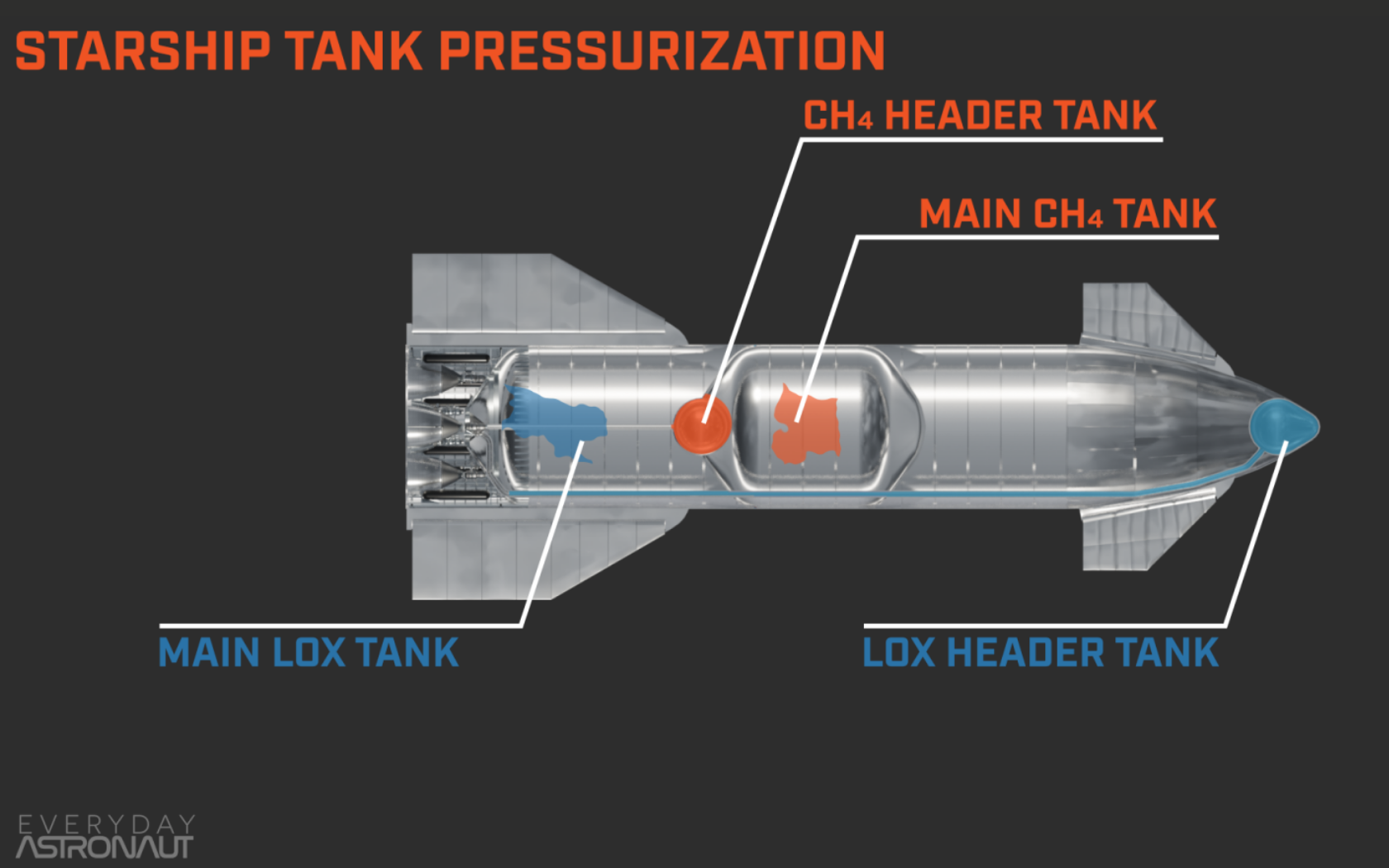
Sometimes, [multiple] header tanks are placed inside other big tanks.
I don't know what they use for the booster. Knowing SpaceX, they'll probably first start with "no part is best part". That's the point of testing, to see how much they can push it.
Cool! So there is enough pressure and flow to light the engines and then you rely on the fuel being pushed to the right end of the tank where the outlet is.
It's interesting that they've put the header tanks upside down relative to each other. Lox header is "above" lox tank but ch4 header is below its tank.
It's interesting that they've put the header tanks upside down relative to each other. Lox header is "above" lox tank but ch4 header is below its tank.
Huh...I guess that's true...
Random question I meant to ask last time. Why don't rockets use bag tanks? At least for the in atmosphere phase? Actually even out of atmosphere they might work because as the bag shrinks there would be nothing to replace the void, but then there's no atmospheric pressure pushing in on the skin of the ship so the vacuum wouldn't matter.
A big bag plus bungee straps holding it down would stop it sloshing around.
This has been done, especially for small amounts of non-cryogenic fuel such as what a satellite would carry. But for larger tanks, the bladder would add a lot of weight and dealing with cryogenic effects. Really complicates the idea.
This has been done, especially for small amounts of non-cryogenic fuel such as what a satellite would carry. But for larger tanks, the bladder would add a lot of weight and dealing with cryogenic effects. Really complicates the idea.
Awesome, thanks both, makes sense 👍Also, the internal pressure in the tank contributes a fair amount to the vehicle's strength. Like a sealed drink can vs. an opened one. If the fuel is in a bladder instead, the tank walls have to be stronger and therefore heavier.
This may well be due to their relative mass. liquid oxygen is more than twice as heavy per litre than liquid methane, and you need more of it. Mass distribution in an otherwise largely empty starship would be important.It's interesting that they've put the header tanks upside down relative to each other. Lox header is "above" lox tank but ch4 header is below its tank.
Last edited:
We finally got a new detail about the cause of Starship explosion in the last test.
View: https://youtu.be/-LtMDhfOPIE?t=2591
43:15
Elon said that after the successful hot stage separation, they started intentionally venting liquid oxygen due to lack of on-board cargo. If the cargo was there, that fuel would be used/would not be loaded. Venting led to the fire, and the explosion.
Goals for third Starship orbital attempt:
- reach orbit
- test in-orbit fuel transfer between internal tanks
- test cargo doors
- fire up engines for returning to earth
Version 2 and 3 of starship are getting ready, V3 will be even larger [140-150 meters tall]. The current one is 121m.
View: https://youtu.be/-LtMDhfOPIE?t=2591
43:15
Elon said that after the successful hot stage separation, they started intentionally venting liquid oxygen due to lack of on-board cargo. If the cargo was there, that fuel would be used/would not be loaded. Venting led to the fire, and the explosion.
Goals for third Starship orbital attempt:
- reach orbit
- test in-orbit fuel transfer between internal tanks
- test cargo doors
- fire up engines for returning to earth
Version 2 and 3 of starship are getting ready, V3 will be even larger [140-150 meters tall]. The current one is 121m.
Sounds like SpaceX has submitted it's IFT2 mishap report to the FAA:
View: https://x.com/OliverNerd7/status/1750155910536695875?s=20
View: https://x.com/OliverNerd7/status/1750155910536695875?s=20
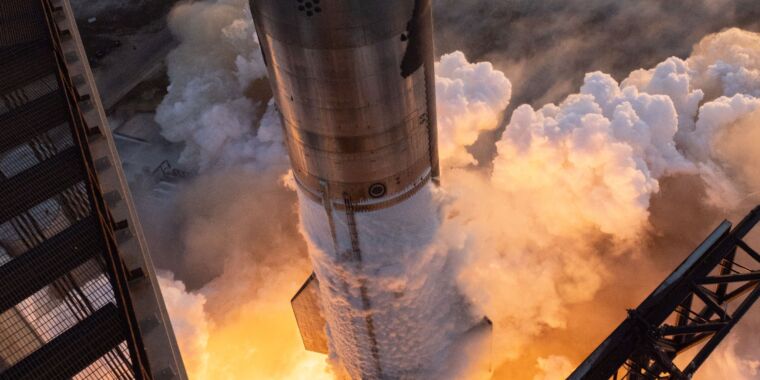
SpaceX discloses cause of Starship anomalies as it clears an FAA hurdle
"Several engines began shutting down before one engine failed energetically."

FAA have closed the mishap report investigation on OTF-2
SpaceX delivered their report Feb 16th and the FAA signed it off on Feb 26th, so a pretty speedy turnaround of ~5 working days. Good going FAA.
SpaceX say they've already completed most of the modifications they suggested as remedies (suggestions accepted by the FAA), so hopefully a new flight license wont be too far behind and it'll be on to OTF-3 in mid-March.



